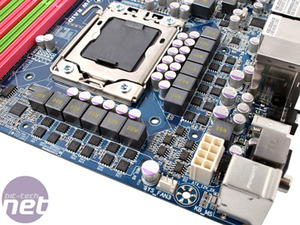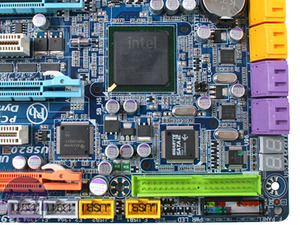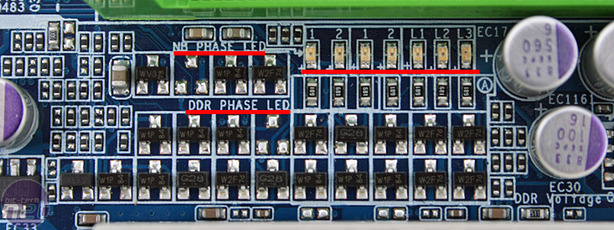Lights, Camera, Action
Up top, Gigabyte includes the same virtual 12 phase CPU power regulation with VRD 11.1 support and six stage power switching from the DES Advanced software that we're used to on its EP45 boards.The northbridge and memory gets a pair of phases too, and while on paper this is less than Asus and MSI, whether it actually makes a difference we'll have to see. As part of the Ultra Durable 3 specification there's the usual environmentally sealed ferrite core chokes and low RDS-on MOSFETs used almost everywhere, as well as the 50-million-squillion hour solid aluminium capped Japanese (likely Fujitsu on the 1.0 revision) capacitors.
Across the board here there are also a few dozen little SMD LEDs that are labelled DDR phase, NB (northbridge) phase, NB temp among other things. We did try to boot the board up with some heatsinks we found elsewhere, but unsurprisingly it merely coughed at us then went back to sleep. During the splutter it was evident that the whole thing lights up like a Christmas tree - there are three LEDs by the southbridge, several shown below and a few more to show the CPU power phases used like usual.
Finally, other features Gigabyte includes are its dual BIOS backup that we know from experience works extremely well indeed, however it's designed for security and redundancy not selectable for "overclockers" who like to play with hand-wavy beta BIOSes like Asus BIOS Flashback hardware allows. To be honest, we prefer this efficient automated service but do accept the appeal that Asus' hardware gives better choice. Gigabyte's UltraTPM is also included, and while we've explained its potential benefits before it still seems to draw very negative reactions - don't worry though because it can be completely turned off if this kind of hardware does cause your bile to bubble.

We have to remind ourselves that this is an early look still and we've still yet a month to go before we get hold of the final retail sample and we know the EX58-Extreme board has already changed once in the last month or so. Yet, we can't but help feel a little "meh" compared to the other X58 boards we've seen.
It's yet another evolution not revolution from Gigabyte and while its conservative nature means it's to some degree guaranteed not to go wrong and affect sales, without venturing out to try new things there's also no chance of getting it much more right either. Launching the EP45-Extreme board was a great opportunity to try and do something different, to push the boundaries and justify the higher price, not just roll into the norm of slapping a big heatpipe on it and a waterblock on the northbridge that seems so popular these days.
The fundamentals of the Gigabyte X58 are certainly solid enough and if you like its boards to date it's very likely to be yet another to stick on the shopping list, but we do hope Gigabyte gets a serious injection of mojo sometime soon, simply to avoid becoming stale.

MSI MPG Velox 100R Chassis Review
October 14 2021 | 15:04












Want to comment? Please log in.